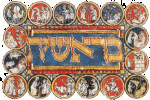
What is a Soul? III. The Many Souls of Man
…[H]e who tries to cure the soul, wishing to improve the moral qualities, must have a knowledge of the soul in its totality and

…[H]e who tries to cure the soul, wishing to improve the moral qualities, must have a knowledge of the soul in its totality and

In the biblical story of the creation of Adam, the Torah states: Then the Eternal G‑d formed man of the dust of the ground, and

Introduction “In the beginning G‑d created the heavens and the earth.” (Genesis 1:1) “In the beginning G‑d created the heavens and the earth,” the Torah

On the Eve of Shabbat, we received a government mailing containing documents that we were required to fill out and send back to the Census

And out of the ground made the Lord G‑d to grow every tree that is pleasant to the sight, and good for food; and the

And the Lord spoke unto Moses, saying: ‘Command the children of Israel, and say unto them: When ye come into the land of Canaan, this

March 14 is celebrated by nerds around the world as the Pi Day. When written in digits, 3/14 represents first three digits of the number

In the six hundredth year of Noah’s life, in the second month, on the seventeenth day of the month… all the fountains of the great

In the last post, Tishrei—Past, Present, and Future, we discussed how all Tishrei holidays – Rosh HaShanah, Yom Kippur, Sukkot, and Simchat Torah – are
Listen, O heavens, and I will speak! And let the earth hear the words of my mouth! (Deut. 32:1) In this Torah portion Haazinu, Moses
The previous Lubavitcher Rebbe, the Rebbe Rayatz (a.k.a. the Fridriker Rebbe) told the story about his father, the Rebbe Rashab. Once the brother of Rebbe

If a bird’s nest chances before thee in the way, in any tree or on the ground, with fledglings or eggs, and the mother sitting

The Torah portion Re’eh, begins with the verse: Behold, I set before you this day a blessing and a curse. (Deut. 11:26) The first word

The Talmud (tr. Shabbat) discusses two opinions about the manner in which we are to light Chanukah menorah. According to Hillel, we light the first
What came first, the Schrödinger cat or the fig of Rabbi Akiva? You be the judge. Today we present a guest post by Rabbi Dr. David
This post is a continuation of the earlier post, The End of Days I. In this Torah Portion, Shemot, we read about the encounter between
In this Torah portion, Vayechi, Jacob, gathers his children to reveal to them “Ketz HaYamim”–“the End of Days.” Rashi explains that Jacob’s intention was to
B’reshit bara Elokim et hashamaim v’et haaretz… In the beginning, G‑d created heaven and earth… Alternative translation: With two beginnings G‑d created heaven and earth…
Presented at the International Torah and Science Conference in Miami International University on December 18, 2005 Alexander Poltorak Introduction. This is the third in